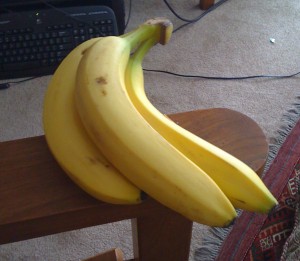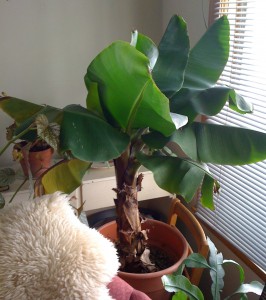
The single most consumed fruit in America, yet in the tropics this bananas starchy relatives play an even more vital role in feeding whole nations.
At the Plant and Animal Genome Conference next month (which I really wish I was going to), there will be a workshop on banana genomics, but from the abstract submitted by Carine Charron (h/t to Jeremy at the Agricultural Biodiversity Weblog) I learned that:
The sequencing phase will be completed in early 2010 and automatic annotation will take place during the first semester of 2010.
Why is sequencing the banana genome important? Three reasons:
- Despite their image in western cuisine, bananas (particular starchy varieties) are a vital food source for people living throughout the tropics (especially in countries like Uganda and Rwanda where bananas supply close to a third of peoples total calories in a day)
- Because most farmed bananas are sterile breeds, crop breeding (used to great effect to increase yields and disease resistance in most crops of bananas importance) is impossible. A sequenced genome will make it easier to plan and test genetic engineering approaches to increasing the diseases and stress resistance (as well as yield) of bananas.*<– I really enjoyed writing this footnote
- Banana will be the first non-grass monocot to be sequenced. Grasses evolved from the monocots, the same way that birds evolved from dinosaurs. You can’t define a common ancestor of all dinosaurs that isn’t also the ancestor of birds.**

The ancestor of all grasses from turfgrass to corn to bamboo, probably had more in common with this dwarf banana than its wildly successful descendants
As someone who studies grass genomes, the chance to see what the genomes of monocots looked like before the big evolutionary breakthroughs that lead to grasses (one of the younger and most successful groups of plants on the face of the planet if I do say so myself***) is like a bird scientist getting a chance to sequence the genome of a dinosaur species that had somehow survived to the present day. Yes, with only one non-grass monocot genome it’ll be hard to stay which parts represent banana specific changes and which parts are unchanged from the common ancestor of all monocots, but it’ll still be way more than we know today.
The banana genome has been promised before, this story from back in 2001 claimed it would be sequenced in less than five years and been the third genome ever sequenced. But this time it’s actually happening. The sequence data is pouring in, the assembly (putting pieces of the genome together like a giant jigsaw puzzle) and annotation (figuring out which pieces of the genome are actually genes) will soon begin if they haven’t already.
My thanks and appreciation go out to the scientists involved in the complex effort sequencing the banana genome entails (and before that the possibly even more complex effort of getting funding to pay for the sequencing). I know you’re doing it for the people who depend on bananas for food, but you’re making my work as a comparative genomicist even more interesting than it already was (something that seems almost impossible).
If you’re interested in bananas check out my previous posts on the history of the banana and banana biology.
*In fact a lot of the work scientists have done studying the genetic changes that have been selected for during domestication of crops like corn could be leveraged to introduce similar changes in banana. One example is the selection for corn that doesn’t compete as much with its neighbors (reduced shade avoidance response), leaving more energy left over for producing a large ear. The same trait has been selected for in many crops that reproduce sexually. Norman Borlaug’s dwarf wheat is an extreme example of the same principle (although it that case there were also benefits to nitrogen use efficiency). If similar changes were introduced to bananas, farmers would be able to plant bananas closer together and produce more bananas per acre. That sort of change is the closest to a free lunch as you’re going to get in ag research.
**People who study how species are related to each other get very annoyed when anyone starts taking about groups of species that doesn’t have a common ancestor that isn’t the ancestor of any other species not in the same group (such bad groupings are called paraphyletic clades but don’t worry that name isn’t going to be on the midterm). To them birds ARE dinosaurs, because otherwise looking at the group of non-bird dinosaurs is defining a paraphyletic group. For the same reason grasses ARE monocots. I understand why defining groups properly is important to them, and it generally will make biology make more sense, but sometimes I do need to talk about paraphyletic groups like non-grass monocots.
***For most intents and purposes, grasses didn’t exist when dinosaurs walked the earth, yet today grasslands cover 20% of the earth’s land area, and along the way the productivity of key crops like corn, wheat, and rice (all grasses) creating the surpluses of food enabled human civilization.
Very cool. I also saw at JGI yesterday that they are working on Brassica rapa, Boechera stricta, and Arabidopsis arenosa and halleri. Plus the Capsella rubella and Arabidopsis lyrata genomes should be coming out soon. These will help fill in the brassicaceae family pretty nicely. Plus they also list Eucalyptus globulus, Miscanthus giganteus, Phaseolus vulgaris, Panicum virgatum plus another maize variety Zea mays ssp. mays Mo17. Pretty cool how many plants are getting sequenced now, and that was only JGI. Almost too much information to deal with.
Comment by Noah Fahlgren — December 30, 2009 @ 2:14 pm
There are so many more genomes in the pipeline, it’s hard to believe only two years ago the number of plant genomes stood at 4. I know someone who has had a peak at the pre-release lyrata sequence and she’s really excited about it and Capsella will also be really exciting when it comes out. On the grass side the two I’m most excited about are Brachypodium distachyon (already available and should be published sometime soon) and Setaria italica (foxtail millet) though I know much less about where that genome project stands.
We’re definitely going to have to come up with new ways to study with the flood of sequence information that is already starting which is one of the reasons I’m so excited to be studying comparative plant genomics.
Comment by James — December 30, 2009 @ 4:39 pm